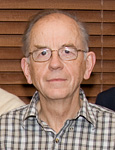Alan Allnatt
Research Areas
Statistical Mechanics and Thermodynamics
Education
B.Sc. (University of London); Ph.D. (University of London)
Research
Since retirement I no longer support a research group of my own but I still collaborate with other research groups where possible. My current interests are mostly in the applications of statistical mechanics to models of the matter transport and thermodynamic properties of solids. I am pursuing essentially analytical methods and leaving full scale computer simulations to others!
Theories of matter transport in solids are usually based on "stochastic models” . These are defined in terms of atom and point defect concentrations and interaction energies, plus the jump frequencies of elementary atom movements, e.g. atom-vacancy exchanges. A central problem is to express the Onsager phenomenological coefficients in terms of these model parameters. Such expressions are used in the interpretation of measured transport coefficients such as diffusion coefficients, mobilities etc. and as input by those who model complex processes, such as matter transport in irradiated alloys and demixing of alloys in chemical potential gradients. The book referenced below summarizes some of the systems and methods of interest. My current work on dilute alloys is focused on the enhancement of diffusion coefficients of solvent and solute due to vacancy-solute interactions. Other developments for dilute alloys of the linear response theory described in the book include extensions to anisotropic crystals and a new route to the evaluation of mechanical relaxation modes. For concentrated alloys we continue the exploitation and further development of the self-consistent kinetic theory for random mixing alloys devised by Moleko, Allnatt and Allnatt.
Atomic transport in solids induced by a temperature gradient (thermotransport) is characterized by the heat of transport parameters defined in non-equilibrium thermodynamics. Despite many experimental studies, sometimes motivated by the use of engineering components in extreme temperature gradients, there is little fundamental understanding or reliable intuition about these parameters. Atomistic theories require calculations of either the perturbation of vacancy and interstitial jump frequencies by the temperature gradient, or of the heat flux associated with isothermal jumps. I recently completed a new formulation of time correlation function expressions for these quantities and have now turned to the much harder problem of establishing approximate analytical methods for their evaluation using lattice dynamics and developments in the statistical mechanics of phonon scattering.
Publications
- A.R. Allnatt and A.B. Lidiard (1993). Atomic Transport in Solids. Cambridge University Press, Cambridge.
- A.R. Allnatt (2001). Time correlation formula for the heat of transport associated with atom-vacancy exchange in a crystal. J. Phys. A: Math. Gen. 34, 7741-7458.
- I.V. Belova, A.R Allnatt and G.E. Murch (2002). Collective and tracer diffusion kinetics in the ternary random alloy. J. Phys. Condens. Matter 14, 6897-6907.
- A.R. Allnatt, I.V. Belova and G.E. Murch (2006). Atom Transport in random two sublattice structures: analogue of the random alloy sum rule. Phil. Mag. 86, 5837-5846.
- I.V. Belova, A.R Allnatt and G.E. Murch (2007). Interdiffusion in strongly ionic insulating materials: the Nernst-Planck equation. Phil. Mag. 87, 4169-4180.


